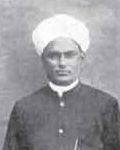G. A. Natesan
Ganapathi Agraharam Annadhurai Ayyar Natesan (25 August 1873 – 29 April 1948) was an Indian writer, journalist, publisher, politician and freedom-fighter from the erstwhile Madras Presidency. He was the founder and proprietor of G. A. Natesan & Co. which published nationalist books, the most prominent among whom was The Indian Review.
Ganapathi Agraharam Annadhurai Ayyar Natesan | |
|---|---|
 G. A. Natesan in 1915 | |
| Born | 25 August 1873 |
| Died | 29 April 1948 (aged 74) |
| Occupation | writer, journalist, politician, publisher |
| Spouse(s) | Mangalamma |
Early life
Natesan was born in the village of Ganapathi Agraharam in Thanjavur district on 25 August 1873. He had his schooling in Kumbakonam[1] He graduated in arts from the Presidency College, Madras[2] and started a career as a publisher. He first apprenticed under Glyn Barlow before starting his own publishing company, G. A. Natesan & Co. in 1897.[2][3]
Indian independence movement
Natesan was involved with the Indian independence movement right from his early days. In 1900, he started The Indian Review, a monthly publication in English.[4] While covering mostly nationalistic themes, The Indian Review also included literary reviews, illustrations and sections on economy and agriculture.[4] Natesan advertised on the front page that his publication was "devoted to the discussion of all topics of interest".[4]
When Mahatma Gandhi visited Madras for the first time since his arrival in India in 1915, he stayed at Natesan's house at Thambu Chetty Street, Georgetown.[5][6] His stay lasted from 17 April 1915 to 8 May 1915.[6]
Later life
In his later life, Natesan underwent a change of ideology and joined the Indian Liberal Party.[7] He was elected Joint Secretary of the Liberal Party in 1922.[7] He was first nominated as a non-official member to the Council of State in 1923 and for a second time in 1931.[7][8] During his tenure as a member of the Council of State, Natesan served as member of the Indian Delegation to the Empire Parliamentary Association in Canada.[1] He also served as the member of the Indian Iron and Steel Tariff Board in 1933-34.[7][9] Natesan was appointed Sheriff of Madras in 1938.[7]
Death
Natesan died on 29 April 1948 at the age of 74. He was extremely active until the time of his death.[1]
Notes
- Siba Pada Sen (1972). Dictionary of national biography. Institute of Historical Studies. pp. 245–246.
- World biography. Institute for Research in Biography. 1948.
- Diamond jublee: sixty years of publishing, 1897-1957. G. A. Natesan & Co. 1957. p. 39.
- Somerset Playne; J. W. Bond; Arnold Wright (1914). Southern India: its history, people, commerce, and industrial resources. pp. 733.
- "The Mahatma: Gandhi and Kasturba". Gandhi Ahsram at Sabarmati. Archived from the original on 6 February 2009.
- "When Gandhi visited Madras". The Hindu. 26 January 2003.
- Clarence Lewis Barnhart; William Darrach Halsey (1980). New Century Cyclopedia of Names. Simon & Schuster. p. 2892. ISBN 0136119476, ISBN 978-0-13-611947-0.
- B. Natesan (1933). Souvenir of the sashtiabdha-poorthi of the Hon. Mr. G. A. Natesan. G. A. Natesan & Co. p. 55.
- Great Britain. Commercial Relations and Exports Dept (1935). India: economic and commercial conditions in India. H.M. Stationery Off. p. 76.
| Wikisource has original works written by or about: G. A. Natesan |